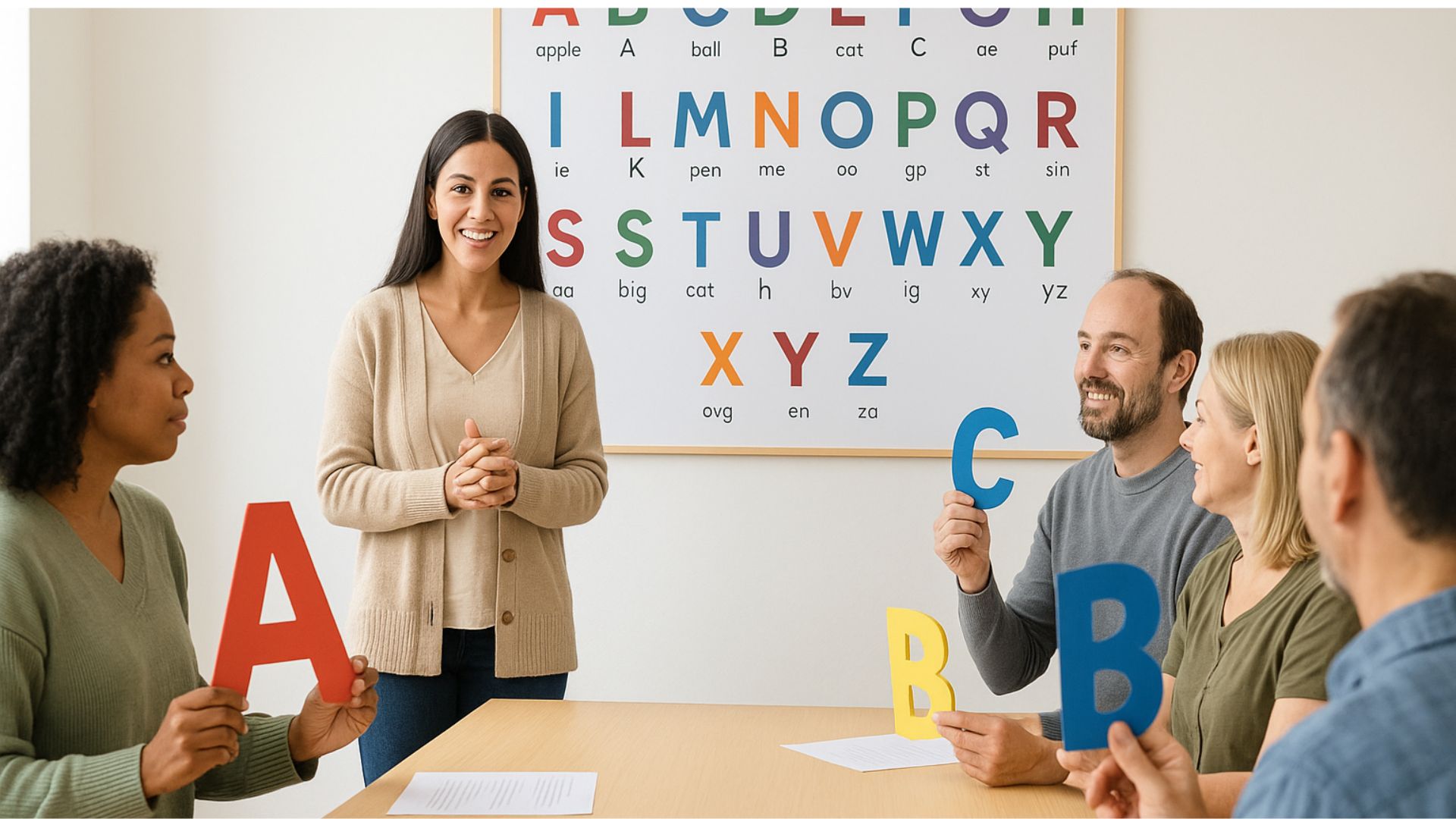Learn the phonetic sounds of the English alphabet. Essential guide for ESL beginners to improve pronunciation and reading skills.

Affiliate Disclosure
Guess what? When you click and buy through our links, you’re doing more than improving your game. You’re supporting us in a way that doesn’t cost you extra but helps us keep bringing you the best drills and tips. It’s a slam dunk for both of us!
First Step
Understanding the phonetic sounds of the English alphabet is a fundamental step in mastering the language. Phonetics bridge the gap between written and spoken English, making pronunciation clearer and learning more effective. Whether you’re a beginner or looking to refine your skills, grasping these sounds will enhance your reading, writing, and speaking abilities.
That is what is known as the English alphabet phonetic sounds. Some of the letters make more than one sound, based on the letters around them and what the word is.
📚 Table of Contents
- What Are Phonetic Sounds in English?
- Alphabet Chart with Phonetic Examples
- Understanding Vowel Sounds
- Common Consonant Sounds
- English Pronunciation Challenges
- Interactive Practice Activities
- Download a Sample Worksheet
- Next Steps in Learning
🔠 What Are Phonetic Sounds in English? {#phonetic-sounds}
Phonetic sounds represent how letters are pronounced, not just their names. For ESL learners, this is key to speaking, reading, and spelling correctly. Instead of focusing on “A, B, C,” phonetics helps learners say words like “apple,” “ball,” and “cat” properly.
🔡 Alphabet Chart with Phonetic Examples {#alphabet-chart}
Here is a quick look at the alphabet with phonetic examples:
| Letter | Sound | Example |
|---|---|---|
| A | /æ/ | apple |
| B | /b/ | ball |
| C | /k/ or /s/ | cat / cent |
| D | /d/ | dog |
| E | /ɛ/ or /iː/ | bed / eat |
| F | /f/ | fan |
| G | /g/ or /dʒ/ | go / giant |
| H | /h/ | hat |
| I | /ɪ/ or /aɪ/ | sit / ice |
| J | /dʒ/ | juice |
| K | /k/ | kite |
| L | /l/ | lemon |
| M | /m/ | milk |
| N | /n/ | nose |
| O | /ɑ/ or /oʊ/ | hot / open |
| P | /p/ | pen |
| Q | /kw/ | queen |
| R | /r/ | red |
| S | /s/ | sun |
| T | /t/ | table |
| U | /ʌ/ or /juː/ | sun / use |
| V | /v/ | van |
| W | /w/ | water |
| X | /ks/ | box |
| Y | /j/ or /aɪ/ | yes / fly |
| Z | /z/ | zoo |
✨ Understanding Vowel Sounds {#vowel-sounds}
Vowels can have more than one sound. Here’s a simple breakdown:
Short Vowels:
- A: /æ/ – cat
- E: /ɛ/ – bed
- I: /ɪ/ – sit
- O: /ɑ/ – hot
- U: /ʌ/ – sun
Long Vowels:
- A: /eɪ/ – cake
- E: /iː/ – see
- I: /aɪ/ – bike
- O: /oʊ/ – home
- U: /juː/ – cute
🔊 Common Consonant Sounds {#consonants}
Most consonants are straightforward, but a few can change:
- C – /k/ (cat), /s/ (cent)
- G – /g/ (go), /dʒ/ (giant)
- Th – /θ/ (think), /ð/ (that)
- S – /s/ (snake), /z/ (is)
- X – /ks/ (box) or /gz/ (example)
❗ English Pronunciation Challenges {#pronunciation-challenges}
English has tricky rules. Here are a few examples:
- Silent letters: “K” in knight, “B” in thumb
- Homophones: Words that sound the same, like pair and pear
- Irregular rules: ough in through, rough, though, cough—all different!
- 🔑 Tip: Listen and practice often. Don’t rely only on spelling!
🗣️ Interactive Practice Activities {#activities}
- Minimal pairs: ship/sheep, bit/beat
- Listening drills: Match the word to its sound
- Repeat after audio: Record yourself mimicking sounds
- Phonetic symbol puzzles: Match sound to symbol
📄 Download a Sample Worksheet {#worksheet}
🚀 Next Steps in Learning {#next-steps}
🎯 Want to practice live with a tutor?
Book lessons on italki
📚 Prefer structured learning?
🛍️ Need a full phonics lesson for your classroom or tutoring?
Check out the Alphabet & Phonics Lesson in my TPT store
👥 Practice with others for free
Join the Study Buddy Project — Sign up here to access our private Facebook group.
What do you think? I’d love to hear your thoughts. Is this lesson helpful? What do you like about it? What do you not like? Leave comments and questions in the space below. I always reply.


Thank you for this comprehensive guide on the English alphabet and its phonetic sounds. As someone who is keen on mastering English, I found your explanations extremely helpful, especially the part about how vowels and consonants can change their sounds. I’m intrigued by the exceptions in English pronunciation you mentioned. Could you perhaps provide more examples or even dedicate a future post to this topic? I’m looking forward to your upcoming lessons!
Thanks for your comments Dreamgirl93. I’m glad you found the article helpful. Yes, of course I can and will provide addtional lessons on this subject. It is such a basic element in learning the English language that those of us who speak English as a first language take for granted. Someone who is trying to learn English as a second language, or maybe even a third language or more, often get very confused about this topic. That’s why I’m here.
Visit as often as you like.
KBob
This is a great article. Those English numbers could be the cause of some problems in early math(s).
In early years quite a lot of work needs to be done with the teen numbers because of their reversed nature.
Thirteen is written 13, but the third part of the word indicating three comes first! Ditto all the other numbers up to nineteen.
Heck, even eleven and twelve can be confusing because they seem like made-up names without much of an obvious link to the arrangement of the digits.
In Welsh, the teen numbers (and subsequent multiples of ten + a digit) are called one-ten-one; one-ten-two etc and then two-ten, two-ten-one, two-ten-two and so on.
Other languages have similar naming conventions to Welsh.
Simon
Thanks for your comments Simon. I never thought about the pronunciation of the teens in English. I’m glad you brought it to my attention. I know in Spanish, they say the teens in the manner you mentioned for at least some of them. For example: 13 is trece, 14 is catorce, and 15 is quince, althought 16 is diez y ses (10 and 6), 17, 18, and 19 are diez y siete, diez y ocho, and diez y nueve.
We learn something new every day.
Feel free to leave other questions and comments any time. I will promptly respond.
As a non-native English speaker, I find this article very helpful. I think the article explains the English alphabet and numbers in a clear and easy way. I can learn how to write and pronounce letters and numbers correctly. I can also practice my listening and reading comprehension by watching the video.
I think this article is a valuable resource and starting point for anyone who wants to improve English as a second language or communicate better with native speakers.
I appreciate you for creating this article and sharing it with us.
Thanks for your comments Pablo. I will assume your first language is Spanish. Hablo poco Espanol pero no much. Let me know if you have questions or if I can help you with anything related to English. If you know anyone else, who needs help, that’s what I’m here for.
Feel free to leave comments or questions any time. I will promptly respond.
KBob
Thanks.
You’re welcome. Leave comments and questions any time. I will promptly reply.
KBob
English phonetics is such an interesting subject. Thanks for this article about it. The chart is particularly helpful. As you mentioned, the letters around a particular letter can change the sound of that letter. I think one interesting example of that is how the letter “l” changes the sound of “a” as in all, calm, talk, and halt. And yet, just when you think you’ve got it figured out, you have to go back and make an exception, like in half and talc. The good thing is that we can start with basic phonics rules, and just fine tune them, like you tune a violin with the pegs first and then finish with the fine tuners.
Hi Danette, thanks for your comments. I always tell my students that rule number 1 is, English is a crazy language.Whenever anything confusing comes up, I remind them of that.
KBob